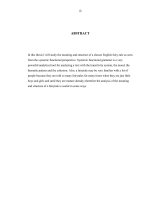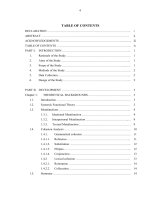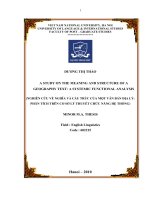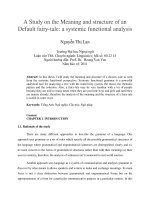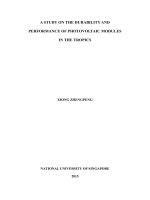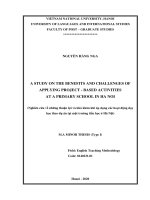A study on the perception and use of cohesive devices in english essays of twelfth graders at hermann gmeiner high school dalat
Bạn đang xem bản rút gọn của tài liệu. Xem và tải ngay bản đầy đủ của tài liệu tại đây (1.85 MB, 112 trang )
MINISTRY OF EDUCATION AND TRAINING
HO CHI MINH CITY UNIVERSITY OF TECHNOLOGY
---------------------------
NGO QUANG TUNG
A STUDY ON THE PERCEPTION AND USE
OF COHESIVE DEVICES IN ENGLISH
ESSAYS OF TWELFTH GRADERS AT
HERMANN GMEINER HIGH SCHOOL DALAT
Major: English Language
Course code: 60220201
HO CHI MINH CITY, NOVEMBER,2020
i
MINISTRY OF EDUCATION AND TRAINING
HO CHI MINH CITY UNIVERSITY OF TECHNOLOGY
---------------------------
A STUDY ON THE PERCEPTION AND USE
OF COHESIVE DEVICES IN ENGLISH
ESSAYS OF TWELFTH GRADERS AT
HERMANN GMEINER HIGH SCHOOL DALAT
Submitted to the
Faculty of English Language
in partial fulfillment of the Master’s degree in English Language
Course code: 60220201
By
NGO QUANG TUNG
Supervised by
NGUYEN THI KIEU THU, Ph.D.
HO CHI MINH CITY, NOVEMBER,2020
ii
The thesis entitled A study on the perception and use of cohesive devices in
English essays of twelfth graders at Hermann Gmeiner high school- Dalat
was successfully defended and approved on 12/01/2021 at Ho Chi Minh City
University of Technology (HUTECH).
Academic supervisor:
NGUYEN THI KIEU THU, Ph.D.
(full name, title, signature)
Examination Committee
1. LE VAN TUYEN, Ph.D.
Chair
2. TRAN QUOC THAO, Ph.D.
Reader 1
3. CAO THI PHUONG DUNG, Ph.D.
Reader 2
4. LE THI THUY NHUNG, Ph.D.
Member
5. TRAN THI MINH PHUONG, Ph.D.
Secretary
Member
On behalf of the Examination Committee
Chair
(full name, title, signature)
iii
HCMC UNIVERSITY OF TECHNOLOGY
POSTGRADUATE INSTITUTE
HCMC,1/12/2020
MASTER’S THESIS REPORT
Student name: NGO QUANG TUNG
Sex: Male
Date of birth: 09/12/1994
Place of birth: DakLak
Major: English Language
Student code: 1841900006
I- Thesis title:
A study on the perception and use of cohesive devices in English essays of
twelfth graders at Hermann Gmeiner high school- Dalat
II- Objectives and contents:
This research aims to investigate the perception of English cohesive devices of
twelfth graders at Hermann Gmeiner High School and to analyze how they use
English cohesive devices in writing essays.
More specifically, the data was collected through questionnaire and writing
essay. At first, 85 students were required to complete the questionnaire in
relation to the students’ perception of cohesive devices. Then, the chosen
participants were asked to write two 250-word essays in which cohesive devices
were identified and analyzed in terms of types, frequency of each type and
iv
correctness of usage. This research applied questionnaire and documentation
study as the two main instruments to gather information.
III- Starting date:
30/10/2019
IV- Completing date:
1/11/2020
V- Academic supervisor:
NGUYEN THI KIEU THU, Ph.D.
ACADEMIC SUPERVISOR
FACULTY DEAN
(full name, signature)
(full name, signature)
v
CERTIFICATE OF ORIGINALITY
I certify my authorship of the Master’s Thesis submitted today entitled:
A STUDY ON THE PERCEPTION AND USE OF COHESIVE DEVICES
IN ENGLISH ESSAYS OF TWELFTH GRADERS AT HERMANN
GMEINER HIGH SCHOOL - DALAT
In terms of the statement of requirements for Thesis in Master’s programs
issued by the Higher Degree Committee of Faculty of English Language, Ho
Chi Minh City University of Technology.
Ho Chi Minh City, November 2020
NGO QUANG TUNG
vi
RETENTION AND USE OF THE THESIS
I hereby state that I, NGO QUANG TUNG, being a candidate for the degree of
Master of Arts (English Language) accept the requirements of the University
relating to the retention and use of Master’s Theses deposited in the Library.
In terms of these conditions, I agree that the original of my Master’s Thesis
deposited in the Library should be accessible for purposes of study and research,
in accordance with the normal conditions established by the Librarian for the
care, loan, and reproduction for theses.
Ho Chi Minh City, November, 2020
Signature …………………………….
NGO QUANG TUNG
vii
ACKNOWLEDGEMENTS
Completion of this study is being attributed to the efforts and encouragement of
many individuals. I would like to take this opportunity to express my heartfelt
thanks to them all. This research would not have been possible during the entire
process of undertaking and completing this study without their valuable
assistance.
I would first like to express my deepest gratitude to Dr. Nguyen Thi Kieu Thu,
my supervisor, for her patience, guidance, insightful advice, and constant
encouragement through the whole research process. Without her support and
guidance, this thesis would never have been completed.
I am very grateful to all my teachers of the Post-Graduate Department at Ho Chi
Minh City University of Technology (HUTECH) for their valuable lectures,
from which a great deal of knowledge of the language and particularly of the
methodology of language teaching was drawn. Without their insightful lessons
and a great deal of valuable experience, I would not have enough knowledge
and skills to get my thesis completed on time and excellently.
Many special thanks also go to Hermann Gmeiner high school students and
teachers for their support and motivation. Without them, I could not have
focused on my studies.
viii
ABSTRACT
For many EFL students, writing skills are difficult and challenging to learn and
develop. Cohesion is also considered as one of the most problematic in writing
that the majority of English learners have dealt with.
Based on the taxonomy of cohesive devices developed by Halliday and Hasan
(1976), this paper aims to investigate the perception of English cohesive devices
of twelfth graders at Hermann Gmeiner High School and to analyze how they
use English cohesive devices in writing essays. More specifically, the data was
collected through questionnaire and writing essay. In this research, 85 students
were required to complete the questionnaire in relation to the students’
perception of cohesive devices. Then, the chosen participants were asked to
write two 250-word essays in which cohesive devices were identified and
analyzed in terms of types, frequency of each type and correctness of usage.
The results of the present study indicate that the students’ perception of
cohesive devices was neutral, and students were able to apply a variety of
cohesive devices in their writing. While grammatical devices were used the
most, lexical cohesive devices were relatively neglected by the students. In
addition, personal reference was used correctly the most in total number of
correctness of usages in each type of cohesive devices, whereas, it can be noted
that personal reference and collocation had the highest frequency of errors.
The researcher has drawn some pedagogical implications from the study
findings for both learners and teachers, as well as guidelines for further studies
on this field.
Keywords: cohesive devices; writing essays; students’ perception
ix
TABLE OF CONTENTS
CERTIFICATE OF ORIGINALITY ............................................................ vi
RETENTION AND USE OF THE THESIS ................................................ vii
ACKNOWLEDGEMENTS ......................................................................... viii
ABSTRACT .................................................................................................... ix
TABLE OF CONTENTS ................................................................................ x
LIST OF TABLES ....................................................................................... xiii
LIST OF FIGURES ...................................................................................... xv
CHAPTER 1 .................................................................................................... 1
INTRODUCTION ........................................................................................... 1
1.1 Background to the study .......................................................................... 1
1.2 Statement of the problem ......................................................................... 4
1.3 Aims and objectives of the study ............................................................. 4
1.4 Research questions .................................................................................. 5
1.5 Scope of the study ................................................................................... 5
1.6 Significance of the study ......................................................................... 6
1.7. Definition of key terms ........................................................................... 7
1.7.1. Perception ........................................................................................ 7
1.7.2. Cohesion .......................................................................................... 7
1.7.3. Cohesive devices ............................................................................. 7
1.8. Organization of the study........................................................................ 9
CHAPTER 2 .................................................................................................. 11
LITERATURE REVIEW ............................................................................. 11
2.1 Introduction ........................................................................................... 11
2.2 Definition of Essay writing .................................................................... 11
2.3 Importance of Essay writing .................................................................. 13
2.4 Perception ............................................................................................. 14
2.4.1 Students’ Perception ....................................................................... 14
2.4.2 The Importance of Students’ Perception ......................................... 15
2.4.3 Types of Perceptions....................................................................... 16
2.5 Cohesion in English ............................................................................... 16
x
2.5.1. The definition of cohesion ............................................................. 16
2.5.2 The function of cohesion ................................................................ 18
2.5.3 The concept of tie ........................................................................... 20
2.5.4 Taxonomy of Cohesion ................................................................... 20
2.6 Correctness ............................................................................................ 36
2.7 Previous studies ..................................................................................... 37
2.8 Conceptual framework .......................................................................... 40
2.9 Summary ............................................................................................... 42
CHAPTER 3 .................................................................................................. 43
METHODOLOGY ........................................................................................ 43
3.1 Introduction ........................................................................................... 43
3.2 Research design ..................................................................................... 43
3.3 Research site.......................................................................................... 43
3.4 Sample and sampling procedures ........................................................... 44
3.5 Research instruments ............................................................................. 45
3.5.1 Questionnaire.................................................................................. 46
3.5.2 Students’ essays .............................................................................. 47
3.6 Data collection procedures..................................................................... 48
3.7 Data analysis procedures ....................................................................... 50
3.8 Validity and Reliability ......................................................................... 52
3.9 Summary ............................................................................................... 53
CHAPTER 4 .................................................................................................. 54
RESULTS AND DISCUSSIONS .................................................................. 54
4.1 Results................................................................................................... 54
4.1.1 Results from questionnaire.............................................................. 54
4.1.2 Results from essay analysis ............................................................. 58
4.2 Discussion ............................................................................................. 68
4.2.1 The perception of cohesive devices of twelfth graders at HGHS ..... 68
4.2.2 How twelfth graders used CDs in their essays. ................................ 69
4.3. Summary .............................................................................................. 72
CHAPTER 5 .................................................................................................. 73
CONCLUSION ............................................................................................. 73
5.1 Summary of the main findings of the thesis ........................................... 73
5.2 Pedagogical implications ....................................................................... 74
xi
5.3 Limitations ............................................................................................ 77
5.4 Recommendations for further research .................................................. 78
REFERENCES .............................................................................................. 79
APPENDIXES ............................................................................................... 87
APPENDIX A ................................................................................................ 87
QUESTIONAIRE .......................................................................................... 87
QUESTIONAIRE .......................................................................................... 89
(Vietnamese version) ..................................................................................... 89
APPENDIX B ................................................................................................ 91
Questionnaire Reliability .............................................................................. 91
APPENDIX C ................................................................................................ 92
One sample essay paper mark ...................................................................... 92
APPENDIX D ................................................................................................ 93
Categories of cohesive devices in essays written by 12th graders at Hermann
Gmeiner high school...................................................................................... 93
APPENDIX E: Endorsement form............................................................... 94
APPENDIX F: Plagiarism check result ....................................................... 95
xii
LIST OF TABLES
Table 2. 1: Personal reference in English (Halliday and Hasan 1976, p.38) ..... 24
Table 2. 2: Demonstrative reference in English (Halliday and Hasan 1976, p.38)
........................................................................................................................ 25
Table 2. 3: Comparative reference in English (Halliday and Hasan 1976, p.39)
........................................................................................................................ 26
Table 2. 4: The classifications of additive conjunction (Halliday and Hassan
1976, p.243) .................................................................................................... 31
Table 2. 5: The classifications of adversative conjunction (Halliday and Hassan
1976, p.243) .................................................................................................... 32
Table 2. 6: The classifications of causal conjunction (Halliday and Hassan 1976,
p. 243) ............................................................................................................. 33
Table 2. 7: The classifications of casual conjunction (Halliday and Hassan 1976,
p.243) .............................................................................................................. 34
Table 3. 1: Cohesive devices investigated in the current study ........................ 49
Table 3. 2 : Information about teachers who checked the essays and their code52
Table 4. 1 Overall Mean Scores ...................................................................... 54
Table 4. 2 Mean scores of students’ perception of cohesive devices. ............... 55
Table 4. 3 Mean scores of students’ perception of Reference. ......................... 56
Table 4. 4 Mean scores of students’ perception of Conjunction. ...................... 56
Table 4. 5 Mean scores of students’ perception of Reiteration ......................... 57
Table 4. 6 Mean scores of students’ perception of collocation. ........................ 58
Table 4. 7 the differences and similarities in three teachers’ results ................. 58
xiii
Table 4. 8 Frequency of grammatical and lexical cohesion. ............................. 59
Table 4. 9 Frequency of sub-types of grammatical cohesion. ........................... 60
Table 4. 10 Frequency of sub-types of reference ............................................. 60
Table 4. 11 Frequency of sub-types of conjunction. ........................................ 61
Table 4. 12 Frequency of sub-types of lexical cohesion. .................................. 61
Table 4. 13 Frequency of sub-types of Reiteration........................................... 62
Table 4. 14 Frequency and percentage of the correctness of usages in each type
of cohesive devices. ........................................................................................ 63
Table 4. 15. Frequency and percentage of errors in using cohesive devices. .... 64
xiv
LIST OF FIGURES
Figure 2. 1 The concept of tie (Halliday and Hasan 1989) ............................... 20
Figure 2. 2 Cohesive devices (Halliday and Hassan, 1976) .............................. 22
Figure 2. 3 Types of reference (Halliday and Hasan 1976) .............................. 24
Figure 2. 4: Conceptual framework of the current study .................................. 41
xv
CHAPTER 1
INTRODUCTION
1.1 Background to the study
Writing has been considered as the most problematic language skill for English
learners. Kroll (1990) points out that writing is frequently a difficult skill for
both native and nonnative speakers. What is more, Prommas and Sinwongsuwat
(2011) point out that writing is more challenging than speaking due to the
reason that there are no nonverbal expressions like gestures, facial expressions
in written communication which help to confirm the properly presented
message. Therefore, it is essential for English learners to know how to write
clearly the message to the readers. Furthermore, English learners should master
the formal and structural properties of language as well as be aware of the
mechanics of academic writing. It requires the students not only the ability to
construct grammatical sentences but also the ability to construct a cohesive text.
Applying cohesive devices in writing is challenging for EFL learners. Ahmed
(2012) shows the result that students have difficulty with all aspects of cohesion
by conducting the research about Egyptian university students’ perception.
Moreover, Tangkieng (2010) illustrates that even students who are at an
advanced level of proficiency in EFL also encounter obstacles with cohesion.
According to McDevitt (1989), the definition “spaghetti writing” (p.19) is
given, which means that students create the long non-cohesive sentences.
Despite the fact that advanced students who get a high level in syntactic
structure and lexicon of English, they still produce mistakenly with cohesion
(Kaplan, 1966). Nonnative writers, in other words, fall into the dilemma of
writing not because of lacking proficiency in syntax and lexis (Hatch, 1992).
Inappropriate using cohesion devices or linking words lead to misunderstanding
1
and even communication breakdown, according to Yomiyama (1980). Oshima
and Houghe (1991) state EFL students apply excessively cohesive devices,
which makes it become “boring to read and difficult to focus on the ideas
expressed.” Hence, cohesive devices are overused or improperly used, which
contributes to the text without semantic and syntactic features.
There are some pressing reasons that could be adopted to address the problems
in the use of cohesive devices in EFL writing. First, cohesive devices are
insufficiently paid attention to in classes. According to Halliday and Hasan
(1976), the foundation of coherence is cohesion, which is a pivotal prerequisite
to the text. Dozens of students think that grammar is the only tool on which they
can rely heavily in their essay without paying attention to cohesion. Berman
(1994) concludes that people who acquire language tend to gravitate towards the
usage of grammar, spelling, and punctuation. In fact, Celce and Olshtain (2000)
pinpoint that the ability to express ideas with reasonable coherence and
accuracy is the key term for being a successful writer in a foreign language.
Besides, it is challenging to employ cohesive devices due to the fact that it
requires much practice. The visible difficulties are facing with producing
grammatical and meaningful sentences, and it is much harder to connect
sentences.
In fact, most students tune out the applying of a certain word or phrase that
plays an important role in connecting two sentences. In order to achieve good
cohesion, students should know how to use effectively cohesive devices which
stick their sentences together. It is not challenging for readers to follow the
ideas, and eventually, good cohesion leads to good writing as Enkvist (1990)
states that writing must have surface cohesion. It is necessary to resolve the
cohesion problems in the writing process. If it was not resolved, student’s
writing would lack important cohesion element. In other words, it is hard to
2
understand their writing because of losing sense since the ideas are not linked
smoothly and clearly.
Moreover, cohesion is considered as one of the most important criteria in
writing assessment. For instance, for the IELTS test, candidates are evaluated as
being good at writing when they can apply a range of cohesive devices
appropriately as well as manage all aspects of cohesion well. Therefore, English
learners should pay attention to cohesion due to its importance in English
writing. It is necessary to let students who are at high school education level in
Vietnam know how the importance of cohesion in writing is due to the fact that
at that level, they start learning how to write the essay. As a result, cohesion
should be focused more in terms of teaching writing at the high school level in
Vietnam in general and Hermann Gmeiner Dalat School in particular.
In the case of the students at Hermann Gmeiner High School in Dalat (HGHS),
although most of them have learned English since they were in primary school,
the majority of them have problems with writing. Also, they do not have many
occasions to practice writing English due to the reason that English is just a
foreign language in Vietnam. Moreover, they do not know exactly how the
importance of cohesion in writing, and they also meet a lot of difficulties when
trying to connect the sentences. These factors are difficult for the students in HG
to turn into advantages to achieve better English writing. Furthermore, to
achieve the cohesion in writing, cohesive devices are a vital aspect that hugely
contributes to successful writing. Thus, students should pay attention to use
appropriately cohesive devices in English essays.
The issues mentioned above provide a general picture of the research focus that
can lead to the question why this study should be conducted.
3
1.2 Statement of the problem
It is obvious that English is one of the most important subjects and is
compulsory in the Vietnamese educational system. English subject is being
taught in terms of four major skills: speaking, listening, reading, and writing.
Among the four language skills, the majority of Vietnamese students often find
writing the most difficult to master. As a result, both teachers and students in
Vietnam put many efforts into writing by the awareness of the importance of
this skill. However, it has still been immensely tough for those who are in the
process of language acquisition.
Moreover, writing is an issue that many students at HGHS in Dalat have been
dealing with. Many students do not have good writing skill in the 10th grade and
even in the 12th grade. One of the most problematic in writing that HG students
have to face is cohesion. Because of the failure to create cohesion, the students
often cause misunderstanding for the readers, such as their teachers and
classmates. Another consequence is to lead students in a situation that they
cannot get high scores in writing tests due to the absence of cohesion.
According to Ahmed (2012), cohesion is one of the most significant aspect
which can be used to evaluate students’ writing skill. It is considered as
unsatisfactory writing skills when students are not able to apply cohesion
appropriately. That is why they should improve how to create cohesion
correctly. In fact, there is not much research in using cohesive devices at high
school level, especially in HGHS. Therefore, it is essential to conduct this
research.
1.3 Aims and objectives of the study
This study aims at investigating the twelfth graders’ perceptions of cohesion in
English essays and the way they apply cohesive devices in writing English
essays. The objectives of this study are as follows.
4
To investigate the perception of English cohesive devices of twelfth
graders at Hermann Gmeiner High School.
To analyze how twelfth graders at Hermann Gmeiner High School use
English cohesive devices in writing essays in terms of types, frequency
of each type, and correctness of usage.
1.4 Research questions
In order to accomplish the preceding objectives, the following research
questions must be addressed:
1. How do the twelfth graders at Hermann Gmeiner High School perceive
English cohesive devices?
2. How do the twelfth graders at Hermann Gmeiner High School use
English cohesive devices in writing essays in terms of types, frequency
of each type, and correctness of usage?
1.5 Scope of the study
The study is conducted at HGHS in Dalat city. This study focuses on two
aspects that are students’ perception of cohesion in English essays and the way
they use cohesive devices in writing English essays in terms of frequency,
semantic and syntactic features. Other aspects of writing, namely coherence,
writing structure, punctuation, and other grammatical points, are not involved in
this study.
The participants are twelth graders currently attending HGHS and are chosen on
the basis of convenient sampling. The researcher is currently teaching them, so
it is convenient to conduct the research on them for saving time and not
affecting the studying schedule. Besides, the participants are in 12th grade, and
at this level, students are able to write English essays. In comparison, 10th and
5
11th graders do not know how to write English essays.
Due to the fact that the researcher would like to investigate students’ perception
of cohesion in English essays, and the way they apply cohesive devices, this
study mainly focuses on students. Teachers are also involved in this study with
the role of supporters to assess the students’ essays as a reliable factor.
1.6 Significance of the study
Theoretically, the result of this research is supposed to contribute and provide
additional information that can help other researchers conduct further
educational research development in the field of cohesion.
Practically, it is desired that the result of this research will help students notice
the importance of cohesion in essay writing, which leads them to satisfactory
writing skills. The research also gives information in understanding the very
basic principles of cohesive devices, which helps students know what to say and
how one sentence or paragraph is in relation to another sentence or paragraph.
Besides, teachers can base on this study to find out the good and bad things
about students’ perception of cohesion in English essays in order to enhance
their students’ writing. Teachers can also discover the way students use
cohesive devices to help them make use of advantages and reduce the
disadvantages through the result of this study. The outcome of this study will be
a source of reference for teachers to know better the student’s perception of
cohesion as well as the way their students use cohesive devices. Besides, this
research provides the sources for teachers and educators to explore their skills to
understand cohesive devices which is often used in writing.
6
1.7. Definition of key terms
To avoid any mistake in interpreting the title of this research, the research needs
to explain the terms relating to it. The terms are as mentioned below.
1.7.1. Perception
According to Schacter, Glbert, and Wegner (2009), perception is defined as the
association, identification, and the explanation of a sensation in consideration of
pointing out a psychological illustration. In this study, the researcher desired to
investigate the students’ perception of cohesive devices.
1.7.2. Cohesion
According to Wignell (1994), cohesion mentions the materials in the language
that supply continuity in a text, over and above that is achieved by clause
structure and clause complexes. Sentences connect to each other in terms of
semantic relation within a text, which means they are dependent on that of
another.
1.7.3. Cohesive devices
Rini (2009) defines “Cohesive devices are clues used by speakers and hearers to
find the meanings which underlie surface utterances.” Moreover, Halliday and
Hasan (1976) show that there are five major cohesive devices: reference,
substitution, ellipsis, conjunction and lexical cohesion. In this study, reference,
substitution, conjunction and lexical cohesion were mainly focused on due to
the fact that substitution and ellipsis were hardly applied in academic and
mainly found in spoken discourse, so these two types of cohesive devices were
not included in the current study.
7
1.7.3.1. Reference
Gerot and Wignell (1994, p.170) pinpoint that reference is considered as
systems that introduce and track the identity of participants through text.
Applying personal pronouns, demonstratives, and comparatives which creates a
cohesive relation between the cohesive item and its antecedent.
1.7.3.2. Substitution
Halliday and Hasan (1976, p.31) show that substitution is the replacement of
one component by another at a specific place in a structure. In English, the
substitute plays the role as a noun, as a verb, or as a clause. One, same, do, and
not are some items used commonly in substitution.
1.7.3.3. Ellipsis
According to McCarthy (1991, p.43), “Ellipsis is the omission of elements
normally required by the grammar which the speaker or writer assumes are
obvious from the context and therefore need to be raised”. Halliday and Hasan
(1976, p.143) indicate that ellipsis is substitution by zero, which means that an
item in a text is replaced by nothing. Moreover, the reader and listener still can
understand this meaning by looking back to the preceding item.
1.7.3.4. Conjunction
Baker (1992) shows that conjunction takes the role to connect sentences, clause,
and paragraphs to each other by using the formal markers. It is not similar to
reference, substitution, and ellipsis, conjunction is used in a way which does not
guide the reader to afford missing information either by looking for it elsewhere
in the text or by filling structural slots. Instead, conjunction shows the way for
readers to stick to what is about to be mentioned and what has been referred to
before.
8
1.7.3.5. Lexical cohesion
Gerot and Wignell (1994, p.177) mention to the lexical cohesion as
relationships between and among words in a text. There are two main types:
reiteration and collocation. Halliday and Hasan (1976) describe reiteration as
two components that experience the identical referent and could either be
repeated or have analogous meanings in a text. Reiteration has formed as
repetition, synonymy, antonym, and super ordination. Moreover, according to
Platridge (2012), collocation is defined as a combination of vocabulary items
that co-occur together.
1.8. Organization of the study
Apart from the acknowledgment, the abstract, the list of figures, and tables, this
research consists of 5 chapters, a list of references, and appendices.
- Chapter 1 (Introduction) presents background, statement of the
problem, aims and objectives, research questions, scope, significance, and
definition of the key terms.
- Chapter 2 (Literature Review) lays the theoretical foundations for the
whole research, and summarizes, evaluates past research related to this
research in the field of cohesive devices.
- Chapter 3 (Methodology) presents the way research has been
conducted, including the place and time the study was carried out, the
materials, techniques, samples, data, approaches were used in the study,
and the procedures were employed.
- Chapter 4 (Findings and Discussion) presents the results of the
research and provides interpretation and analyses of major patterns found
in the data. In addition, literature in the research area is discussed to show
9
the similarities and differences in the findings.
- Chapter 5 (Conclusion) wraps up the thesis by providing a summary of
the main findings of the thesis, implications of the research, limitation of
the research, recommendations for further research, and references.
10
